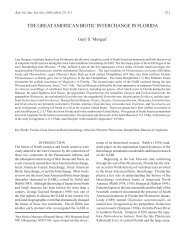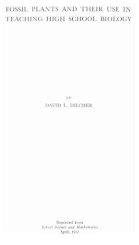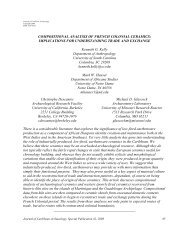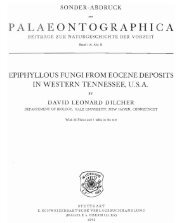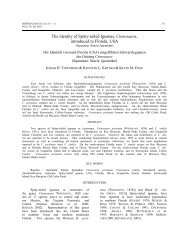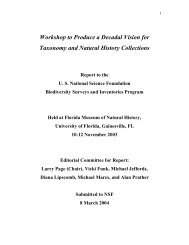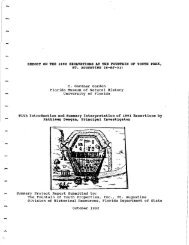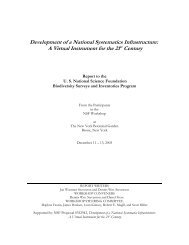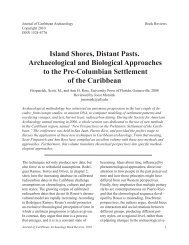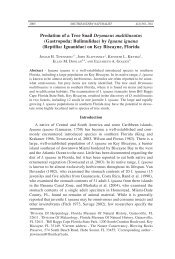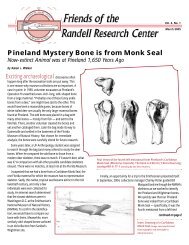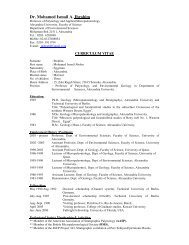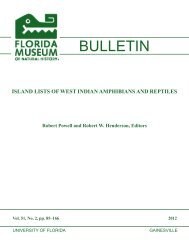Early angiosperms from the Lower Cretaceous of Jixi, eastern ...
Early angiosperms from the Lower Cretaceous of Jixi, eastern ...
Early angiosperms from the Lower Cretaceous of Jixi, eastern ...
Create successful ePaper yourself
Turn your PDF publications into a flip-book with our unique Google optimized e-Paper software.
G. Sun, D.L. Dilcher / Review <strong>of</strong> Palaeobotany and Palynology 121 (2002) 91^112 95<br />
rations <strong>from</strong> bed 12 yielded species such as Canningia<br />
pistica Helby, Kiokansium polypes (Cooks.<br />
et Eis.) Below, Muderongia testudinaria Burger,<br />
Muderongia tetracantha (Gocht.) Alberti, Oligosphaeridium<br />
complex (White) Davey et Williams,<br />
and Palaeoperidium cretaceum Pocock. Sun et al.<br />
(1992b) suggest that <strong>the</strong> age <strong>of</strong> <strong>the</strong> dino£agellate<br />
assemblage <strong>from</strong> bed 12 is Valanginian^Hauterivian.However,<br />
He and Sun (2000) studied <strong>the</strong><br />
dino£agellates <strong>from</strong> <strong>the</strong> lower part <strong>of</strong> <strong>the</strong> Chengzihe<br />
Formation <strong>of</strong> <strong>Jixi</strong> and reported <strong>the</strong> following<br />
taxa: Odontochitina operculata (O.Wetzel) De£.<br />
et Cooks., Muderongia tetracantha (Gocht.) Alberti,<br />
Batioladinium? exiguum (Alberti) Brideaux,<br />
Gardodinium trabeculosum (Gocht.) Alberti, Palaeoperidium<br />
cretaceum Pocock, Kiokansium sp.,<br />
Escharisphaeridia pocockii (Sarj.) Erkmen et Sarjeant,<br />
Circulodinium asymmetricum (Burger) He et<br />
Sun, Nyktericysta puyangensis Wang et Qiao and<br />
Oligosphaeridium jixiense He et Sun.These two<br />
authors considered <strong>the</strong> age <strong>of</strong> marine bed 12<br />
yielding <strong>the</strong> dino£agellates to be late Hauterivian,<br />
and <strong>the</strong> age <strong>of</strong> <strong>the</strong> lower part <strong>of</strong> <strong>the</strong> Chengzihe<br />
Formation to be late Valanginian^late Hauterivian<br />
(He and Sun, 2000).Therefore, we suggest<br />
that <strong>the</strong> age <strong>of</strong> <strong>the</strong> early <strong>angiosperms</strong> collected<br />
<strong>from</strong> beds 27^47 in <strong>the</strong> Chengzihe Formation is<br />
late Hauterivian or late Hauterivian^early Barremian<br />
(Fig.2).<br />
The Chengzihe Formation is conformably overlain<br />
by <strong>the</strong> coal-bearing Muling Formation.The<br />
two formations correspond to <strong>the</strong> lower part <strong>of</strong><br />
Lipovich Formation and Ussuri Formation, dated<br />
as Barremian^Aptian age.These correlations can<br />
also be extended to <strong>the</strong> Ussuri Formation, which<br />
is <strong>the</strong> equivalent <strong>of</strong> <strong>the</strong> Older Suchan Formation<br />
<strong>from</strong> <strong>the</strong> neighboring Suchan Basin which overlies<br />
<strong>the</strong> Berriasian^Valanginian marine beds (see Fig.<br />
3 for details <strong>of</strong> this correlation).Therefore, <strong>the</strong><br />
Muling Formation is considered middle^late Barremian<br />
to early Aptian, while <strong>the</strong> whole Chengzihe<br />
Formation is considered Valanginian (or late<br />
Berriasian) to late Hauterivian (or early Barremian)<br />
in age (Sun et al., 1992a,b, 2000).<br />
Only about 80 specimens <strong>of</strong> angiosperm megafossils<br />
have been collected <strong>from</strong> <strong>the</strong> Chengzihe<br />
Formation by <strong>the</strong> authors so far, including <strong>the</strong><br />
three angiosperm reproductive organs described<br />
here, while specimens <strong>of</strong> <strong>the</strong> o<strong>the</strong>r plants associated<br />
with <strong>the</strong> <strong>angiosperms</strong> number nearly 1000.<br />
That means <strong>the</strong> early angiosperm megafossils are<br />
rare (about 8%) in <strong>the</strong> assemblage.This is also <strong>the</strong><br />
case when <strong>the</strong> pollen <strong>from</strong> <strong>the</strong>se sediments was<br />
examined (Shang, 1997). Brenner and Bicko¡<br />
(1992) and Brenner (1996) also found that early<br />
angiosperm pollen is present at only very low percentages<br />
in <strong>the</strong> Valanginian^Hauterivian <strong>of</strong> Israel.<br />
Dilcher and Farley (1988) noted in Cenomanian<br />
age sediments that 63^75% <strong>of</strong> <strong>the</strong> megafossils recovered<br />
were <strong>angiosperms</strong> while only 21^23% <strong>of</strong><br />
<strong>the</strong> miospores recovered were <strong>angiosperms</strong>.This<br />
demonstrates that angiosperm diversity and abundance<br />
dominate as megafossils long before <strong>the</strong>y<br />
do so in <strong>the</strong> miospore record.<br />
There are only a few specimens which are compressions<br />
and with cuticle preserved.The preparations<br />
for anatomical study <strong>of</strong> <strong>the</strong> reproductive<br />
axis and <strong>the</strong> cuticles <strong>of</strong> <strong>the</strong> angiosperm leaves<br />
were made with Schultze solution for <strong>the</strong> macerations,<br />
and scanning electron microscopy (SEM)<br />
observations were made with a JAL-3600 SEM.<br />
The surface <strong>of</strong> <strong>the</strong> reproductive axis was examined<br />
with Zeiss epi£uorescence and individual pollen<br />
and clusters <strong>of</strong> pollen grains were studied.<br />
Often extreme oblique light was used to discern<br />
<strong>the</strong> nature <strong>of</strong> <strong>the</strong> leaf margins and <strong>the</strong> venation<br />
while studying <strong>the</strong> specimens with a Wild M 500<br />
dissecting microscope.The described specimens<br />
are housed in Nanjing Institute <strong>of</strong> Geology and<br />
Palaeontology, Academia Sinica, Nanjing, China.<br />
3. Systematics<br />
The following early angiosperm taxa <strong>from</strong> <strong>the</strong><br />
<strong>Early</strong> <strong>Cretaceous</strong> Chengzihe Formation <strong>of</strong> <strong>Jixi</strong>,<br />
China are described in this paper: Asiatifolium<br />
elegans Sun, Guo et Zheng emend.Sun et Dilcher,<br />
<strong>Jixi</strong>a pinnatipartita Guo et Sun emend.Sun et<br />
Dilcher, <strong>Jixi</strong>a chengzihensis Sun et Dilcher sp.<br />
nov., <strong>Jixi</strong>a sp., Shenkuoa caloneura Sun et Guo<br />
emend.Sun et Dilcher, Zhengia chinensis Sun et<br />
Dilcher gen.et sp.nov., Xingxueina heilongjiangensis<br />
Sun et Dilcher, Xingxuephyllum jixiense<br />
Sun et Dilcher gen.et sp.nov., Reproductive organ<br />
A, Reproductive organ B.



